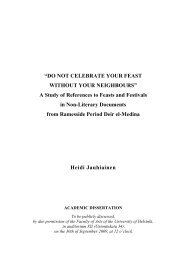BIA
bia51
bia51
You also want an ePaper? Increase the reach of your titles
YUMPU automatically turns print PDFs into web optimized ePapers that Google loves.
FÉVRIER 2015<br />
were held in the building until the early 16 th<br />
century, almost at the end of the Mameluke<br />
period. But the Ottoman conquest in 1517<br />
turned Egypt from a seat of power to a mere<br />
province, and under such circumstances the<br />
mosque was too big for the provincial<br />
government to maintain and it fell into<br />
disrepair.<br />
During the Ottoman period it was used as<br />
an army storehouse, where supplies such as<br />
tents and saddles were kept. During the<br />
Napoleonic Expedition at the end of the 18 th<br />
century, the contemporary historian ‘Abd al-<br />
Rahmân al-Gabartî reported that it was used as<br />
a fortress and garrison for soldiers.<br />
In the 19 th century, during the rule of<br />
Muhammad ‘Alî Pasha, it became an army<br />
camp and bakery, and later a soap factory.<br />
In 1812, Sheikh al-Sharqâwî, a prominent<br />
sheikh of the time, used some of the mosque’s<br />
marble columns to build the Riwâq al-Sharqâwî<br />
at al-Azhar Mosque. It is even rumoured that<br />
some of the columns were used to build the<br />
Qasr al-Nîl Palace.<br />
At the end of the century the British<br />
occupying forces used the mosque as a bakery<br />
and a slaughterhouse, hence the still-popular<br />
name of al-Madbah al-Ingilîzî (the English<br />
slaughterhouse). This continued until 1915.<br />
Amîn said that several attempts to restore<br />
the mosque failed until 1995, when a<br />
restoration project focussed on cleaning the<br />
mosque, removing some small shops in the<br />
external enclosure and raising the height of the<br />
walls to prevent future incursions.<br />
However, cracks were found in the walls of<br />
the northern riwâq (prayer hall). The Ministry of<br />
Culture blamed the contracting company, which<br />
said that the cracks were related to the<br />
mosque’s poor condition.<br />
Work was halted, and the ministry filed a<br />
lawsuit against the company. In 2000 the<br />
dispute was resolved, and the company<br />
resumed the restoration work. In 2007, the<br />
government of Kazakhstan signed a<br />
cooperation agreement with the Ministry of<br />
Culture to restore the mosque, seeing the<br />
building as marking the achievements of one of<br />
Central Asia’s greatest sons. (Nevine El-Aref,<br />
“Mosque restoration resumes”, Al-Ahram Weekly,<br />
February 26, 2015. Voir également Dînâ ‘Abd<br />
al-‘Alîm, « Reprise des travaux de restauration<br />
de la mosquée Baybars », al-Yawm al-Sâbi‘, 15<br />
février ; Hasan Sâlih, « al-Zâhir Baybars : des<br />
travaux de restauration sans fin », al-Watan, 3<br />
mars).<br />
- -<br />
A Czech expedition directed by Miroslav<br />
BÁRTA recently made a great discovery at the<br />
site of Abûsîr, to the south of the Gîza<br />
Pyramids and between the Pyramids and<br />
Saqqâra.<br />
Abûsîr is the site of the “forgotten<br />
pyramids,” and the Czech expedition has been<br />
working there for many years, first under<br />
Miroslav VERNER, and now under BÁRTA. Last<br />
month it found a tomb at Saqqâra recording<br />
for the first time the name of a queen. Her<br />
name is Khent-kawes, but we know of two<br />
other queens named Khent-kawes.<br />
Khent-kawes I is known from Gîza, where<br />
Egyptologist Silîm Hasan found her tomb in<br />
1932-1933. Some scholars believe that this<br />
Khent-kawes ruled at the end of Fourth<br />
Dynasty of the Old Kingdom, between the<br />
pharaohs Khafre and Menkaure. Her tomb is<br />
unique for a queen, and its construction may<br />
be evidence that she actually ruled in her own<br />
right.<br />
It consists of a huge mastaba that caused<br />
Hasan, its excavator, to designate it as a<br />
fourth pyramid of Gîza. The tomb, which had a<br />
boat located near its southwest corner, is<br />
associated with a settlement that may have<br />
housed the priests who maintained the cult of<br />
the queen after her death.<br />
This is the oldest such settlement to be<br />
found in Egypt, and the tomb is also<br />
associated with a structure that could be a<br />
valley temple. The settlement is surrounded by<br />
an enclosure wall.<br />
The title of the queen was Mother of the<br />
Two Kings of Upper and Lower Egypt, and<br />
these may have been kings of the Fifth<br />
Dynasty. It is also possible that this title can<br />
be read as two separate titles, as the Kings of<br />
Upper and Lower Egypt and Mother of the<br />
Kings of Upper and Lower Egypt.<br />
<strong>BIA</strong> LI — Janvier/Juin 2015 51



